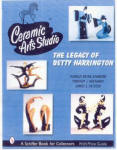|
©1999-2015 |
The Ceramic Arts Studio The following article appeared in WPA Press, Vol. 14, October 2002
ABOUT THE BOOK FOREWORD “Without the stimulus of ballyhoo, an increasing number of Americans are coming to think well of American wares for use as accessories in decoration of the home. The gradual disappearance from the market of imports has had much to do with this attitude, of course. Yet even before recent disturbances, we were beginning to discover a special merit in the creations of our own country, and to note, frequently with great surprise, that given the necessary encouragement our designers and craftsmen were capable of work that could hold its own with that of the best designers and craftsmen anywhere. All the while, we were producing home decorative items of authentic American inspiration, rooted in the traditions of our own soil and our own people, expressive of the social, cultural and regional differences which make the United States so rich in its varied appeal. Let us not slacken in our promotion of things American!” From The Gift and Art Buyer, June 1943 I bought the first Ceramic Arts Studio piece I ever saw. It was in a jewelry store during the early 1950s, when I was looking for a gift to send relatives in Norway. There stood the Square Dance Couple in blue and yellow. When I turned them over and found they were made in Madison, Wisconsin, I thought, “what could be more distinctively representative of the American Midwest than these?” My next encounter with CAS was years later in an antique shop, where I was struck by the sincere simplicity of two figurines in black and white. I turned them over, and to my surprise found the same mark, although the pieces were totally different in character from those I had sent to Norway. I was holding Blythe and Pensive. Again, there was a purchase, and these remain among my favorite CAS pieces. The sincere simplicity in the best realistic works, and a sense of abstract rhythm and movement in the stylized works continue to be what draws me to Ceramic Arts. Favorite pieces beyond those mentioned are the kneeling Madonna with Child in blue; the King’s Jester Flutist and Lutist in black, yellow and white, and most of the stylized dancers and animals. I consider St. George, Lady Rowena, and Archibald the Dragon to be Betty Harrington’s most fanciful and technically challenging production group; here is a marvelous interplay of the heroic and the whimsical. The quality of the under-glaze painting, the rhythmic flow of the design, and the whimsical charm of the interpretation of these characters from medieval lore make them classics of the American figurine. Having long been a professor of art history, I have had to devote considerable attention to the fine arts, but feel completely comfortable with Betty Harrington’s work. It represents, on the one hand, simple sentiments and childlike imagination of the most genuine kind, and on the other hand, pleasing and often exciting interrelationships of form and color. These things are also the stuff of fine arts. Positive characteristics in Harrington’s best work, beyond charm, grace, and vitality, are the qualities of the semi-porcelain bodies and the effectiveness of the painting technique. Ceramic Arts Studio reverted essentially to the under-glaze slip decoration, which over sixty years earlier got the American Art Pottery movement underway. An advancement over the earlier technique was the CAS one-fire method in which the glaze was applied directly over the slip-decorated green ware. This led to fusion of the slip and the glaze, which gives the appearance of a fine enamel. There are, to be sure, many “kitschy” and “cutesy” Ceramic Arts Studio pieces, but one must remember that CAS was, of economic necessity, forced to reach the broadest possible public. The Studio picked up immediately on the demand for small decorative ceramics resulting from the loss of Japanese and German sources during World War II, and material of this type from the war period constitutes a unique body of American ceramic ware. Betty Harrington’s figurines filled the bill precisely. Harrington was genuinely gifted in the area of the charming figurine, and her technical quality remained consistently high. From a standpoint of subject matter, her typical work might be compared to that of Norman Rockwell. Harrington often presented such American genre subjects as black children, square dancers, and barefoot fishing boys in big hats. American life had never before, nor has it since, had such a prominent place in ceramic bric-a-brac. Her figures in historic costume or from the theatre or ballet, on the other hand. reveal exceptional reserve and elegance. There are indications that, had the opportunity presented itself, Harrington could have been as successful in a more rarified artistic atmosphere as she was in doing commercial work for the general public. The problem is that she would then probably not have given us that great legacy of figurines for which her talents were so exceptionally suited, and which even today are accessible to most of us. The Ceramic Arts Studio story is the story of Betty Harrington. Marion John Nelson, Dr. Nelson, long a champion of the work of Betty Harrington, and author of the book “Art Pottery of the Midwest”, died September 6, 2000. This Foreword, which he had graciously consented to provide prior to his illness, is drawn from his various writings about Betty Harrington’s career. We are grateful to Lila Nelson, his wife, for permission to include Dr. Nelson’s comments. The WPA Press thanks member Tim Holthaus for providing this introduction and foreword to the forthcoming book about Ceramic Arts Studio and Betty Harrington, and for allowing us to reprint it in the newsletter. WPA Related sites: |









